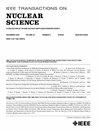A Rapid, Pulsed Laser Testing Approach for Single Event Latch-Up Screening
IF 1.9
3区 工程技术
Q3 ENGINEERING, ELECTRICAL & ELECTRONIC
引用次数: 0
Abstract
Sandia National Laboratories (SNL) has developed a custom pulsed laser single event effects testing facility utilizing a tunable wavelength (680–1080 nm), 140 fs, 80 MHz, Ti:sapphire laser. This system uses a pair of galvanometric mirrors to steer the laser beam across a field-of-view (FOV) to provide a rapid screening capability not available in traditional fixed laser beam testing systems. This article focuses on demonstrating the rapid screening capabilities of the SNL galvo-based laser system by screening an analog-to-digital converter (AD9240) which is known to be sensitive to single event latch-up (SEL). We compare the laser pulse energy thresholds required to induce SEL and the scanning speeds with measurements obtained from a traditional fixed-beam, low-repetition rate laser system. Our results show that rapid detection capabilities can be achieved without compromising SEL threshold determination. Additionally, an integrated imaging system has been designed to provide real-time visualization of SEL-sensitive nodes via emission microscopy (EMMI).单事件闭锁筛选的快速脉冲激光检测方法
桑迪亚国家实验室(SNL)开发了一种定制脉冲激光单事件效应测试设备,利用可调谐波长(680-1080 nm), 140 fs, 80 MHz, Ti:蓝宝石激光。该系统使用一对振镜来引导激光束穿过视场(FOV),以提供传统固定激光束测试系统无法提供的快速筛选能力。本文主要通过筛选已知对单事件锁存(SEL)敏感的模数转换器(AD9240)来展示基于SNL galo的激光系统的快速筛选能力。我们将诱导SEL所需的激光脉冲能量阈值和扫描速度与传统固定光束低重复率激光系统的测量结果进行了比较。我们的研究结果表明,在不影响SEL阈值确定的情况下,可以实现快速检测能力。此外,还设计了一个集成成像系统,通过发射显微镜(EMMI)提供sel敏感节点的实时可视化。
本文章由计算机程序翻译,如有差异,请以英文原文为准。
求助全文
约1分钟内获得全文
求助全文
来源期刊

IEEE Transactions on Nuclear Science
工程技术-工程:电子与电气
CiteScore
3.70
自引率
27.80%
发文量
314
审稿时长
6.2 months
期刊介绍:
The IEEE Transactions on Nuclear Science is a publication of the IEEE Nuclear and Plasma Sciences Society. It is viewed as the primary source of technical information in many of the areas it covers. As judged by JCR impact factor, TNS consistently ranks in the top five journals in the category of Nuclear Science & Technology. It has one of the higher immediacy indices, indicating that the information it publishes is viewed as timely, and has a relatively long citation half-life, indicating that the published information also is viewed as valuable for a number of years.
The IEEE Transactions on Nuclear Science is published bimonthly. Its scope includes all aspects of the theory and application of nuclear science and engineering. It focuses on instrumentation for the detection and measurement of ionizing radiation; particle accelerators and their controls; nuclear medicine and its application; effects of radiation on materials, components, and systems; reactor instrumentation and controls; and measurement of radiation in space.
 求助内容:
求助内容: 应助结果提醒方式:
应助结果提醒方式:


